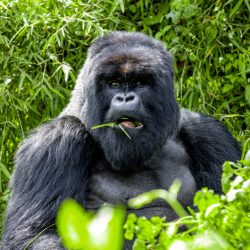A Volcanic Ten Days Tracking Gorillas
Blog | 20/05/10
This is Augustin Basabose, IGCP Conservation Coordinator. The ten days I recently spent counting the legendary mountain gorillas of the Virunga Massif was an experiment in patience, perseverance and discovery. The last census at this site took place in 2003, and therefore it was high time to redo the count to get an idea about the current state of conservation and the size of the population of mountain gorillas living on the slopes of these rainy peaks straddling the Democratic Republic of Congo (DRC), Rwanda and Uganda. A census was planned two years ago, but the insecurity at the site due the protracted war raging in the Eastern DRC, halted our ambitious plans. With the area quiet again now for more than a year, our path was opened up, and we moved quickly to get the count underway.
In the few lines that follow, I would like to share the experience of ten days of intensive activity out in the field counting different mountain gorilla families living in different areas of the Virunga Massif that were allocated to the team to which I belonged.
To properly carry out the census, the Virunga Massif was divided into several sectors to facilitate the counting and communication between different participating teams. On the afternoon of March 15th, 2010 at the edge of gorilla habitat near the Bukima ranger outpost, we decided to spend the night to prepare for the next day-long trip to Mwinanaro camp, located three hours away on foot. The site was strategically chosen to facilitate counting in remote areas farther from the Park’s edge.
The next morning we actually started our journey towards Mwinanaro around 6:30 am, arriving at the camp at about 10 am. We immediately went to work, deciding to do some field explorations in order to reduce the task of the following day. After pitching our tents, we divided into two teams of five individuals as originally planned, and each team left to cover part of the chosen sector in order to reduce the number of working days at the site. The census work was to utilize a reconnaissance route, using trails already made by elephants, buffaloes or trackers until we discovered a fresh gorilla trail, after which we would follow it to the nest site to count nests and assess the composition of the group. In each nest we also collected fecal samples for DNA and parasitological analysis.
A gorilla census is both very exciting and very tiring. While it provides sweeping views of spectacular scenery from the lofty heights of the Volcanoes’ ridges, it also requires a Herculean physical effort to climb the many hills and slopes and slide down the broad valleys in search of gorilla nests. We did have some help, however: we used tools such as compasses, geo referenced maps and GPS to navigate and physically position ourselves throughout the treks.
We left the camp very early in the morning the next day, traversing vast zones throughout the day, returning late in the evening beyond exhaustion. During these long walks, we faced some difficulties inherent to the nature of the forest: the very painful and irritating nettle leaves, which left itchy red welts on the skin, the bite of safari ants, and the constant danger posed by roaming buffalos or elephants, which obliged us to slow down and wait until they went their way.
In addition, the Virunga Massif is well known for its aridity, with small streams and surface water disappearing rapidly due to the high porosity of its volcanic soil. Even during the rainy season, marsh areas do not last long. Water is therefore a scarce resource, which requires one to properly manage their hydration, as they may often travel long distances without finding a single water source. Faced with this reality, park trackers have already developed mechanisms to alter their thirst and water needs. During the rainy season, rainwater is retained in bamboo trunks, entering through pores hollowed out by insects. The trackers use this water to quench their thirst. During our visit in a bamboo forest, I saw our trackers screening bamboo shoots and carefully choosing those they knew contained water. They make a small slit in the trunk to find their liquid nourishment.
Every evening, after planning work for the following day, small talk and funny stories took over around the campfire before we slowly faded off to our tents, one by one, completely exhausted from the long day of walking.
During our ten day stay, our two teams were able to identify four different gorilla families, each consisting of several individuals. The exact composition of each family is to be confirmed later by the DNA analysis of gorilla fecal samples, after which the organizers of the census, led by IGCP in collaboration with our conservation partners, will officially determine the number of gorillas found in each sector. Despite my years of working on gorilla conservation in this area, each day during the census was one of discovery – a whole new world in which to explore. The Virungas’ high biodiversity and ever changing weather and ecosystems guarantee one will never get bored scaling their rugged, misty green peaks. With most of the hard, but exciting, work of the census behind me, I am looking forward to the results. I hope our efforts have paid off, and the gorillas will continue to wander this lush paradise for many years to come.




